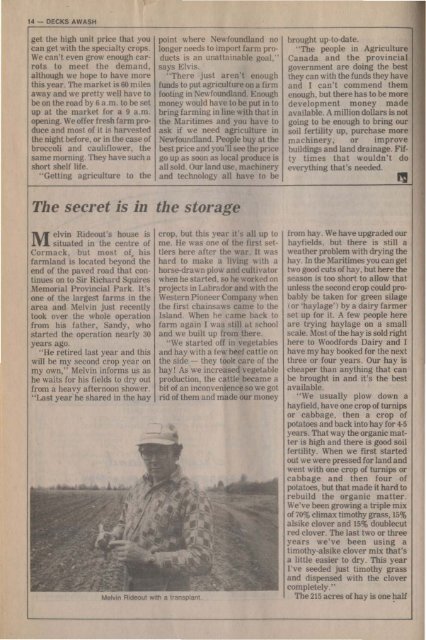Newfoundland - Memorial University's Digital Archives Initiative
Newfoundland - Memorial University's Digital Archives Initiative
Newfoundland - Memorial University's Digital Archives Initiative
You also want an ePaper? Increase the reach of your titles
YUMPU automatically turns print PDFs into web optimized ePapers that Google loves.
14 - DeCKS AWASH<br />
get the high unit price that you<br />
can get with the specialty crops.<br />
We can't even grow enough carrots<br />
to meet the demand.<br />
although we hope to have more<br />
this year . The market is 60miles<br />
away and we pretty well have to<br />
be on the road by 6 a .m. to beset<br />
up at the market for a 9 a.m .<br />
opening. Weoffer fresh farm produce<br />
and most of it is harvested<br />
the night before, or in the case of<br />
broccoJi and cauliflower, the<br />
same morning . They have such a<br />
short shelf life.<br />
"Getting agriculture to the<br />
point where <strong>Newfoundland</strong> no<br />
longer needs to import farm products<br />
is an unattainable goal."<br />
says Elvis.<br />
"There just aren't enough<br />
funds to put agriculture on a firm<br />
footing in <strong>Newfoundland</strong>. Enough<br />
money would have to be put in to<br />
bring farming in line with that in<br />
the Maritimes and you have to<br />
ask if we need agriculture in<br />
<strong>Newfoundland</strong>. People buy at the<br />
best price and YOU'll see the price<br />
go up as soon as local produce is<br />
all sold. Our land use, machinery<br />
and technology all have to be<br />
The secret is in the storage<br />
M<br />
elvin Rideout's house is<br />
situated in the centre of<br />
Cormack, but most of. his<br />
farmland is located beyond the<br />
end of the paved road that continues<br />
on to Sir Richard Squires<br />
<strong>Memorial</strong> Provincial Park. It's<br />
one of the largest farms in the<br />
area and Melvin just recently<br />
took over the whole operation<br />
from his father, Sandy, who<br />
started the operation nearly 30<br />
yea rs ago.<br />
"He retired last year and this<br />
will be my second crop year on<br />
my own," Melvin informs us as<br />
he wails for his fields to dry out<br />
from a heavy afternoon shower .<br />
"Last year he shared in the hay<br />
Melvin Rideout with a transplant<br />
crop. but this year it's all up to<br />
me. He was one of the first set <br />
tlers here after the war. It was<br />
hard to make a living with a<br />
horse-drawn ploy. and cultivator<br />
when he started. so he worked on<br />
projects in Labrador and with the<br />
Western Pioneer Company when<br />
the first chainsaws came to the<br />
Island. When he came back to<br />
farm again I was still at school<br />
and we built up from there .<br />
"We started off in vegetables<br />
and hay with a few beef cattle on<br />
the side - they took care of the<br />
hay! As we increased vegetable<br />
production, the cattle became a<br />
bit of an inconvenience so we got<br />
rid of them and made our money<br />
brought up-to-date.<br />
"The people in Agriculture<br />
Canada and the pr ovincial<br />
government are doing the best<br />
they can with the funds they have<br />
and I can't commend them<br />
enough, but there has to be more<br />
development mo ney made<br />
available. A million dollars is not<br />
going to be enough to bring our<br />
soil fertility up, purchase more<br />
machinery, or im pro ve<br />
buildings and land drainage. Fifty<br />
times that wouldn't do<br />
everything that's needed.<br />
from hay. We have upgraded our<br />
hayfields. but there is still a<br />
weather problem with drying the<br />
hay. In the Maritimes you can get<br />
two good cuts of hay, but here the<br />
season is too short to allow that<br />
unless the second cro p couId probably<br />
be taken for green silage<br />
(or 'haylage') by a dairy farm er<br />
set up for it. A few people here<br />
are trying haylage on a small<br />
scale. Most of the hay is sold right<br />
here to Woodfords Dairy and I<br />
have my hay booked for the next<br />
three or four years. Our hay is<br />
cheaper than anything that can<br />
be brought in and it's the best<br />
available.<br />
"We usua lly plow down a<br />
hayfield, have one crop of turnips<br />
or cabbage, then a crop of<br />
potatoes and back into hay for 4-5<br />
years. That way the organic matter<br />
is high and there is good soil<br />
fertility. When we firs t sta rted<br />
out we were pressed for land and<br />
went with one crop of turnips or<br />
cabbage and then four of<br />
potatoes, but that made it ha rd to<br />
rebuild the organic ma tter .<br />
We've been growing a trip le mix<br />
of 70%climax timothy grass, 15%<br />
alsike clover and 15%doublecut<br />
red clover . The last two or three<br />
years we've been usi ng a<br />
timothy-alsike clover mix that's<br />
a little easier to dry. This year<br />
I've seeded just timothy grass<br />
and dispensed with the clover<br />
completely."<br />
The 215acres of hay is one half
















